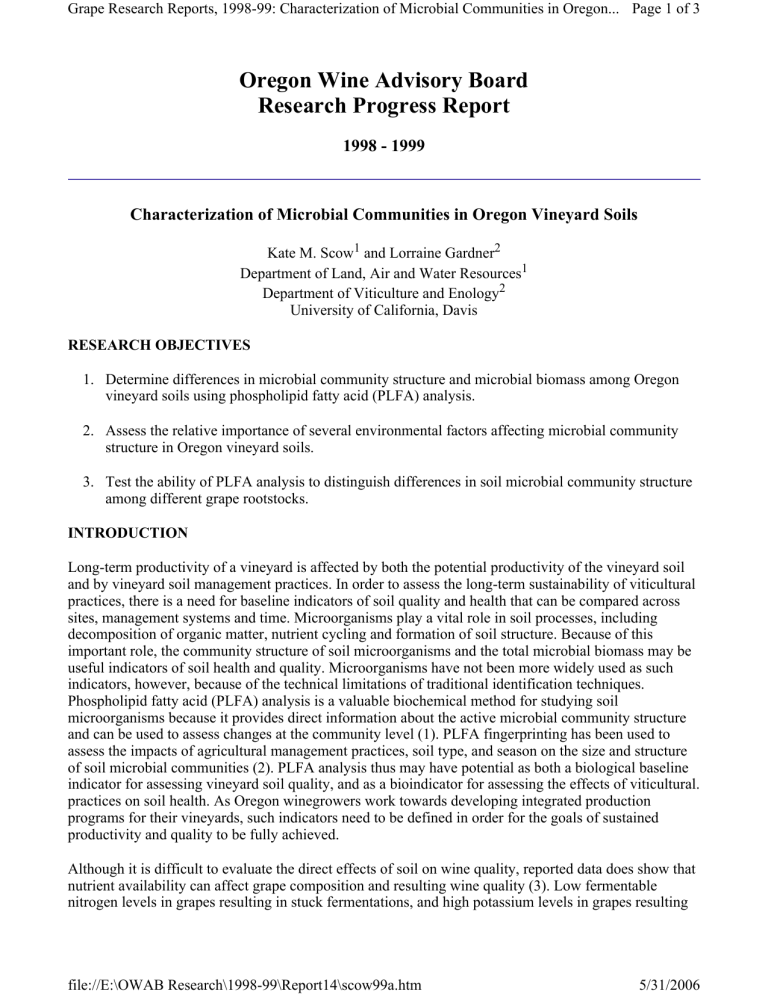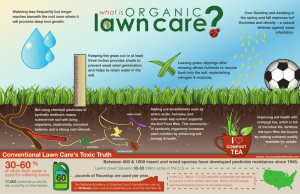Oregon Wine Advisory Board Research Progress Report 1998 - 1999

Grape Research Reports, 1998-99: Characterization of Microbial Communities in Oregon...
Page 1 of 3
Oregon Wine Advisory Board
Research Progress Report
1998 - 1999
Characterization of Microbial Communities in Oregon Vineyard Soils
Kate M. Scow
1
and Lorraine Gardner
2
Department of Land, Air and Water Resources
1
Department of Viticulture and Enology
2
University of California, Davis
RESEARCH OBJECTIVES
1. Determine differences in microbial community structure and microbial biomass among Oregon vineyard soils using phospholipid fatty acid (PLFA) analysis.
2. Assess the relative importance of several environmental factors affecting microbial community structure in Oregon vineyard soils.
3. Test the ability of PLFA analysis to distinguish differences in soil microbial community structure among different grape rootstocks.
INTRODUCTION
Long-term productivity of a vineyard is affected by both the potential productivity of the vineyard soil and by vineyard soil management practices. In order to assess the long-term sustainability of viticultural practices, there is a need for baseline indicators of soil quality and health that can be compared across sites, management systems and time. Microorganisms play a vital role in soil processes, including decomposition of organic matter, nutrient cycling and formation of soil structure. Because of this important role, the community structure of soil microorganisms and the total microbial biomass may be useful indicators of soil health and quality. Microorganisms have not been more widely used as such indicators, however, because of the technical limitations of traditional identification techniques.
Phospholipid fatty acid (PLFA) analysis is a valuable biochemical method for studying soil microorganisms because it provides direct information about the active microbial community structure and can be used to assess changes at the community level (1). PLFA fingerprinting has been used to assess the impacts of agricultural management practices, soil type, and season on the size and structure of soil microbial communities (2). PLFA analysis thus may have potential as both a biological baseline indicator for assessing vineyard soil quality, and as a bioindicator for assessing the effects of viticultural. practices on soil health. As Oregon winegrowers work towards developing integrated production programs for their vineyards, such indicators need to be defined in order for the goals of sustained productivity and quality to be fully achieved.
Although it is difficult to evaluate the direct effects of soil on wine quality, reported data does show that nutrient availability can affect grape composition and resulting wine quality (3). Low fermentable nitrogen levels in grapes resulting in stuck fermentations, and high potassium levels in grapes resulting file://E:\OWAB Research\1998-99\Report14\scow99a.htm
5/31/2006
Grape Research Reports, 1998-99: Characterization of Microbial Communities in Oregon...
Page 2 of 3 in increased wine pH are two direct effects of nutrient availability on wine quality (4,5). Indirect effects of nutrient availability, such as increased shading of fruit due to excessive vigor and increased incidence of rots, can also affect wine quality. Soil microorganisms influence the mineral nutrition of plants by affecting plant physiology and growth, nutrient uptake processes and the availability of nutrients from the soil. Nutrient availability in a given soil therefore depends on the numbers and kinds of microorganisms found in that soil. A better understanding of vineyard soil microbial communities could thus be used to determine soil effects in viticultural ecosystems, and such an understanding might help account for differences in wine quality between viticultural sites.
The presence of phylloxera in Oregon has hastened the need to evaluate grape rootstocks for their adaptability to Oregon soils and growing conditions. Initial rootstock trials in Oregon indicate that rootstock performance varies greatly among sites and that these differences in performance are inconsistent from site to site (6). Studies have revealed differences in soil nutrient uptake rates for different grape rootstocks, but the mechanisms causing these differences remain unclear. (7,8). The addition of soil microorganisms to the grapevine rhizosphere has been shown to affect both vine growth and mineral composition and these effects vary depending upon rootstock and microorganism (9, 10).
PLFA analysis offers a potential tool for assessing whether differences in microbial rhizosphere communities exist among grape rootstocks, and thus may shed some light on observed differences in rootstock performance.
EXPERIMENTAL PROCEDURES
Objective 1
Representative soil samples were collected during bloom from five Willamette Valley Pinot noir vineyards in June 1998 and analyzed for phospholipid fatty acids (PLFA's) using the methods described in Bossio and Scow (2). Sites were chosen to include soils typical of the viticultural area based upon the recommendations of growers and university extension specialists, and include vineyards on the following soil series: Jory, Willakenzie, Bellpine, Nekia and Willamette. The Jory, Willakenzie and
Bellpine sites were sampled again at veraison and harvest. Soil samples were also collected from an adjacent Jory soil in woodland vegetation. All samples were analyzed using a set of twenty eight fatty acids to generate a site-specific PLFA fingerprint and a relative measure of microbial biomass for each site. Using appropriate statistics, differences among soil microbial communities will be quantified and compared.
Objective 2
Representative soil samples were collected from all five vineyards plus the Jory woodland and analyzed for the following by the University of California Division of Agriculture and Natural Resources
Analytical Laboratory according to their Methods of Soil Analysis: pH, EC, cation exchange capacity, particle size distribution, potassium, total phosphorus, total carbon, organic carbon, sulfate, total nitrogen, ammonium nitrogen, and nitrate nitrogen. Soil bulk density, total porosity and field water holding capacity have been determined for all sites using the methods described in Doran and Jones
(11). A growers survey which documents current and past viticultural practices was distributed in
December 1998 to each participating vineyard manager. This information and the results of our analyses are being entered into a computer database that when completed will become available to interested growers and university extension staff. Using appropriate statistics, the effects of soil physical and chemical properties and viticultural practices on soil microbial communities will be compared.
Objective 3
Rhizosphere soil samples were collected at veraison from replicated blocks of six different rootstocks
(Selection Oppenheim 4, Kober 5BB, 3309 Couderc, 101-14 Millardet et De Grasset, Riparia Gloire, and ungrafted Pinot noir) at Oregon State University's comparative rootstock trial located at Woodhall file://E:\OWAB Research\1998-99\Report14\scow99a.htm
5/31/2006
Grape Research Reports, 1998-99: Characterization of Microbial Communities in Oregon...
Page 3 of 3
Vineyard, and the samples were analyzed for PLFA's. Using appropriate statistics, differences among the rhizosphere soil microbial communities for each rootstock will be quantified and compared.
CURRENT PROGRESS
To date, all soil samples have been collected and analyzed for physical properties and PLFA's. We now await laboratory results for soil chemical properties and return of the growers' surveys. Compilation of the growers' responses and statistical analysis of laboratory data should be completed by April 1999. In addition, this survey of Oregon vineyard soils will be included in a larger survey of microbial communities in vineyard soils which includes the following Pinot noir producing areas in California:
Anderson Valley, Mendocino Co.; Russian River Valley, Sonoma Co.; Cameros, Napa/Sonoma Co.;
Chalone, Monterey Co.; Santa Maria Valley, Santa Barbara Co. Results from the California sites will be compared with those from Oregon to determine whether differences in microbial community composition as measured by PLFA analysis are greater between or within viticultural areas. This larger survey of microbial communities in vineyard soils should be completed by June 1999.
REFERENCES
1. Bossio, D.A., Scow, K.M. (1998) Impacts of carbon and flooding on soil microbial communities: phospholipid fatty acid profiles and substrate utilization patterns. Microb. Ecol.
35(3): 265-278.
2. Bossio, D.A., Scow, K.M. (1998) Determinants of soil microbial communities: effects of agricultural management, season, and soil type on phospholipid fatty acid profiles. Microb. Ecol.
3 6(l): 1-12.
3. Jackson, D.I., Lombard, P.B. (1993) Environmental and management practices affecting grape composition and wine quality - a review. Am. J. Enol. Vitic., 44(4): 409-430.
4. Kunkee, R.E. (199 1) Relationship between nitrogen content of musts and sluggish fermentation.
In: International Nitrogen Symposium on Grapes and Wine , J.M. Rantz, Ed., pp. 148-155. Davis,
CA: American Society for Enology and Viticulture.
5. Ruhl, E.H., et al. (1989) Effect of potassium and nitrogen supply on the distribution of minerals and organic acids on the composition of grape juice of Sultana vines. Austr. J. Exper. Agri.
29:133-137.
6. Candolfi-Vasconcelos, M.C., Castagnoli, S. (1997) Cooperative Rootstock Trials: Research
Update. In: OSU Winegrape Research Wine Advisory Board Progress Reports 1996-1997. pp. I -
11. Oregon Wine Advisory Board, Agricultural Experiment Station, Oregon State University,
February, 1997.
7. Grant, R.S., Matthews, M.A. (1996) The influence of phosphorus availability and rootstock on root system characteristics, phosphorus uptake, phosphorus partitioning, and growth efficiency.
Am. J. Enol. Vitic.
, 47(4): 403-409.
8. Brancadoro, L., Valenti, L., Reina, A., Scienza, A. (1994) Potassium content of grapevine during the vegetative period: the role of rootstock. Journal of Plant Nutrition , 17(12): 2165-2175.
9. Bavaresco, L., Fogher, C. (1996) Lime-chlorosis occurrence and leaf mineral composition of grapevine treated by root microorganisms. Journal of Plant Nutrition , 19(l): 87-98.
10. Biricolti, S., Ferrini, F., et al. (1997) VAM fungi and soil lime content influence rootstock growth and nutrient content. Am. J. Enol. Vitic.
, 48(l): 93-99.
11. Doran, J.W., Jones, A.J. (1996) Methods for Assessing Soil Quality . Soil Science Society of
America Special Publication No. 49, Madison, WI. file://E:\OWAB Research\1998-99\Report14\scow99a.htm
5/31/2006





